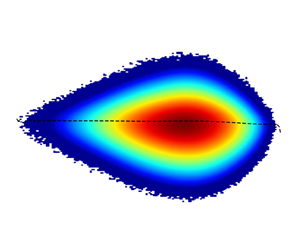Published online by Cambridge University Press: 25 October 2021

In high-Reynolds-number turbulence the spatial distribution of velocity fluctuation at small scales is strongly non-uniform. In accordance with the non-uniformity, the distributions of the inertial and viscous forces are also non-uniform. According to direct numerical simulation (DNS) of forced turbulence of an incompressible fluid obeying the Navier–Stokes equation in a periodic box at the Taylor microscale Reynolds number  $R_\lambda \approx 1100$, the average
$R_\lambda \approx 1100$, the average  $\langle R_{loc}\rangle$ over the space of the ‘local Reynolds number’
$\langle R_{loc}\rangle$ over the space of the ‘local Reynolds number’  $R_ {loc}$, which is defined as the ratio of inertial to viscous forces at each point in the flow, is much smaller than the conventional ‘Reynolds number’ given by
$R_ {loc}$, which is defined as the ratio of inertial to viscous forces at each point in the flow, is much smaller than the conventional ‘Reynolds number’ given by  $Re \equiv UL/\nu$, where
$Re \equiv UL/\nu$, where  $U$ and
$U$ and  $L$ are the characteristic velocity and length of the energy-containing eddies, and
$L$ are the characteristic velocity and length of the energy-containing eddies, and  $\nu$ is the kinematic viscosity. While both conditional averages of the inertial and viscous forces for a given squared vorticity
$\nu$ is the kinematic viscosity. While both conditional averages of the inertial and viscous forces for a given squared vorticity  $\omega ^{2}$ increase with
$\omega ^{2}$ increase with  $\omega ^{2}$ at large
$\omega ^{2}$ at large  $\omega ^{2}$, the conditional average of
$\omega ^{2}$, the conditional average of  $R_ {loc}$ is almost independent of
$R_ {loc}$ is almost independent of  $\omega ^{2}$. A comparison of the DNS field with a random structureless velocity field suggests that the increase in the conditional average of
$\omega ^{2}$. A comparison of the DNS field with a random structureless velocity field suggests that the increase in the conditional average of  $R_ {loc}$ with
$R_ {loc}$ with  $\omega ^{2}$ at large
$\omega ^{2}$ at large  $\omega ^{2}$ is suppressed by the Navier–Stokes dynamics. Something similar is also true for the conditional averages for a given local energy dissipation rate per unit mass. Certain features of intermittency effects such as that on the
$\omega ^{2}$ is suppressed by the Navier–Stokes dynamics. Something similar is also true for the conditional averages for a given local energy dissipation rate per unit mass. Certain features of intermittency effects such as that on the  $Re$ dependence of
$Re$ dependence of  $\langle R_{loc}\rangle$ are explained by a multi-fractal model by Dubrulle (J. Fluid Mech., vol. 867, 2019, P1).
$\langle R_{loc}\rangle$ are explained by a multi-fractal model by Dubrulle (J. Fluid Mech., vol. 867, 2019, P1).